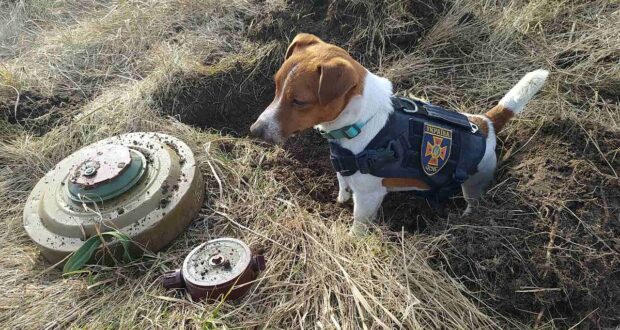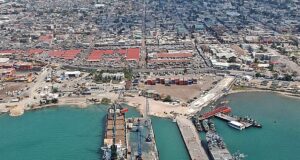1 September, 2023
By Oliver Hegglin – Junior Fellow
Ukraine is now the most heavily mined country on Earth, with about 30% of its territory, more than 174,000 square km, being contaminated with the heaviest concentration of landmines and unexploded ordnance in Europe since the Second World War. This is equal to just over twice the size of Austria. With Ukrainian officials describing the mine-density as “insane”, there being up to five mines per square meter on average in occupied territories and a frontline about 1,000km long, the pace of Kyiv’s counterattack has slowed dramatically.
While this level of mine contamination, “unrecognizable in modern history”, has proven to be a significant obstacle for Ukraine, and an extensive defensive weapon in Russia’s complex obstacle design, the implications of the sheer number of landmines will have far-reaching humanitarian and environmental repercussions for Ukraine’s population for potentially centuries to come. Landmines contaminate farmland and make it unusable for economic activity, thereby exacerbating food insecurity, preventing the delivery of humanitarian aid, causing psychological conditions, driving displacement, and can injure or kill far into the future. These issues affect the human security of the affected population and prevents them from living safe and worry-free lives.
The Counteroffensive
The long anticipated Ukrainian counteroffensive began in June 2023, following months of preparation. Despite initial success, the tempo of the offensive began to lose momentum later in the summer, as liberating occupied territory proved to be a “slow, calculated” process. This, because while Ukraine was gathering and training its forces on newly acquired Western equipment, Russian forces had half a year to fortify their positions, including by densely mining occupied territories, in some cases placing mines on top of mines to destroy more sturdy Western tanks. These defenses run tens of kilometers deep and hundreds of kilometers long, contain not only landmines but also anti-tank ditches, barbed wire, trenches, anti-vehicle obstacles, and bunkers in a “deliberate defense” designed to stop Ukrainian forces as far ahead as possible. But it is the sheer number of the “millions and millions” of landmines that has seemingly forced Ukraine to withdraw Western equipment for risk of them eventually coming to a stop in a minefield and losing them to anti-tank teams or artillery fire.
Further complicating the issue is Russia dropping more mines from the air onto cleared areas and using contamination to funnel Ukrainian forces down routes pre-targeted by artillery. Anti-personnel and anti-tank mines are also reported to be laid side-by-side along with boobytraps, making demining a highly hazardous task. Russia, with its nearly inexhaustible supply of mines, is likely aware of the effect mines are having and has taken to targeting demining equipment and sappers in an effort to further delay the Ukrainian advance. Oleksii Reznikov, Ukraine’s Defense Minister, has admitted to the “critical shortage of men and equipment” able to clear the frontlines, saying they desperately and urgently need more to allow their forces to advance.
As a result of the heavy landmine contamination, the counteroffensive is proceeding at a “creeping” pace. Demining efforts are taking place by hand in an effort to save the few mine-clearing systems Ukraine possesses, and even then, sappers are limited as to when they can work. For as mining technology has advanced in past decades, de-mining technology has not, resulting in improvised solutions, especially during active warfare. Ukrainian sappers wait for darker hours when they are less visible and the air and ground cools, at which point drones with thermal imaging can be launched to identify mines, having retained the summer heat. This is exhausting, slow methodical work. Landmines are proving to be the biggest factor shaping the course of the Russo-Ukrainian War, risking a war of attrition Ukraine cannot afford.
Humanitarian Consequences
By late July 2023, it was believed that some 470,000 hectares of agricultural land in Ukraine were mined. While much of this remains active combat-zones, in liberated areas people are returning to their homes to discover mines and unexploded ordnance, causing a risk of injury and death. As of June 2023, eleven regions in Ukraine are known to be mined: Chernihivska, Dnipropetrovska, Donetska, Kharkivska, Khersonska, Kyivska, Luhanska, Mykolaivska, Odeska, Sumska, and Zaporizka. Natural and man-made environmental disasters, such as the collapse of the Kakhovka Dam in June 2023, have also obscured mine locations, increasing the size of the contaminated area and hiding mines under water and earth. The United Nations claims that from the start of the war in February 2022 to July 2023, some 298 civilians have died and 632 were injured due to mines. The inherent nature of mines also violates International Humanitarian Law (IHL) as they cannot discriminate between combatants and non-combatants. As a result, anti-personnel mines have been banned by the 1997 Mine Ban Treaty.
The “Convention on the Prohibition of the Use, Stockpiling, Production and Transfer of Anti-Personnel Mines and on their Destruction, 18 September 1997”, also known as the “Ottawa Treaty”, is complemented by other international agreements on mine-use designed to limit and end the use of such weapons. The convention calls on states to “never under any circumstance”, use anti-personnel mines, acquire, retain or transfer anti-personnel mines, support in any way any state in acquiring such mines, and to work to destroy all anti-personnel mines. To date, 164 states have become party to this convention, though 33 have not. Though the Mine Ban Treaty prohibits all types of “victim-activated explosive devices”, it does not ban anti-vehicle mines. Ukraine signed the Mine Ban Treaty in 1999 and became a state party in 2006, while Russia has not agreed to the convention. Nevertheless, Russia is technically bound by the restrictions and prohibitions found in the UN Convention on Conventional Weapons, the Geneva Conventions and customary IHL, though these have obviously and blatantly been disregarded during the course of the war to no consequence. There have also been accusations that Ukraine used anti-personnel mines in and around Izium in summer 2022, to which Ukraine responded that it follows international law in its defense and would not comment on weaponry used before the end of the war.
Landmine contamination in Ukraine is so vast, it has been estimated it would take 500 demining teams 757 years to demine the country. The World Bank has estimated a cost of $37.4 billion over the next 10 years. Humanitarian demining is also more painstaking than that of an armed force, as the latter tend to demine corridors through which to advance, leaving the remainder of a minefield for post-war clearance when it is safer, and time and resources are more abundant.
Demining Efforts
Ukraine will be “cleaning” its territory for “many years” post-war, as Defense Minister Reznikov has indicated, saying it is “our future”. Knowing this, the Defense Ministry has been requesting more mine-clearing equipment from partners, pointing out that demining equipment and training is something countries which do not want to provide lethal aid can offer to support Ukraine; It is estimated that over a thousand specialized, armored engineering vehicles exist in European armies which could theoretically be used, should they be transferred to Ukraine. On a civilian level, carrying out surveys as part of humanitarian demining is near impossible while fighting is ongoing, limiting demining efforts. The complex level of contamination is greater than that in other countries such as Afghanistan, Syria and Bosnia-Herzegovina, threatening the recovery effort for hundreds of years, costing billions of dollars, and posing a risk of injury and death to deminers.
Despite this, several organizations are actively working in humanitarian demining in liberated territories in Ukraine, so that agricultural activity can resume and displaced people can return home. On a political level, the Geneva International Center for Humanitarian Deming (GICHD) is supporting Ukraine in developing a national mine-action strategy, while having a plethora of technical information on mines and documenting those used in-country. The Fondation Suisse de Déminage (FSD), a leader in surveying and awareness raising, is actively working to “locate and neutralise” landmines and other unexploded ordnance in Chernihiv, Kharkiv and Mykolaiv, and has been active in the country since 2015.
The HALO Trust, the world’s largest humanitarian demining organization, is training the “largest group of deminers in its history” to “clear the biggest battlefield in Europe”, with the goal of allowing farmers to resume work. 900 locals currently work for the organization, which plans to have 1,200 experts operating by the end of the year. Once mines have been identified, the Ukrainian Armed Forces are informed so they can be removed. Further, the HALO Trust has trained civilians to educate others on the dangers mines pose.
Tip of the Spear Landmine Removal, founded in October 2022, actively works in removing landmines, booby traps, improvised explosive devices, and other explosive objects, in “heavily mined villages and farming areas”. The Mines Advisory Group, active in 25 countries, has gathered evidence of contamination and documented the use of prohibited weapons. It works with the Ukrainian Deminers Association to educate the population to recognize and report contamination, and looks to begin clearance work “in the coming months”.
On a more technological level, Global Clearance Solutions (GCS), with its range of landmine clearance hardware, looks to innovate and use technology to remain on par with landmine technology, offering modern solutions to demining. In Ukraine, the organization is training the State Emergency Service of Ukraine (SESU), the police, and Ministry of Defense, in operating the thirty demining machines Ukraine will receive in 2023. Similarly, a demining machine from the Digger Foundation was transferred to the SESU by the Swiss Armed Forces in June 2023, which has been training with Ukrainian civilian authorities in humanitarian demining since summer 2022 together with the GICHD.
Landmine Legacy
Landmines work. They are always active, require no sleep nor sustenance, and as the Russo-Ukrainian war is showing, are effective in preventing a military advance. While the outcome of this war remains uncertain, countries worldwide are undoubtedly looking at the current state of the war and evaluating the military benefits of mines for themselves. Especially smaller states might see a high defensive value and deterring effect in deploying landmines, while others might consider contamination as a strategy in depriving an adversary of land-use. The proven long-term post-war humanitarian repercussions are likely a secondary consideration in this respect.
While the military benefits are clear, so too are the humanitarian consequences. Countries in the Balkans continue to work on clearance, despite the Yugoslav Wars having ended over twenty years ago. Deminers and others in Bosnia-Herzegovina continue to be injured and killed by mines, even though more than 3,000 square km have been cleared since 1996. About 1,000 square km remain contaminated (in 2021) with about 80,000 mines, and with the goal of clearing Bosnia-Herzegovina by 2025. From 1996 to 2019, 673 people have died and 1,769 were injured, at a time when this country was the most mined in Europe.
These numbers are small compared to the scale of contamination government agencies, humanitarian organizations, the armed forces, and civilians have testified to in Ukraine. It will take decades, if not centuries, to completely clear Ukraine of landmines, throughout which people will continue to be injured and killed. But the demining effort is underway, and every liberated meter and kilometer square cleared of mines is land usable in agriculture and other economic or social activity; it is a step forward in a long process and an opportunity for people to return home and continue their lives in relative safety, peace, and human security.
Patron, a demining dog working for the State Emergency Service of Ukraine, standing next to two defused Russian land mines (Source: State Emergency Service of Ukraine via CC BY-SA 4.0)
 Human Security Centre Human Rights and International Security Research
Human Security Centre Human Rights and International Security Research




